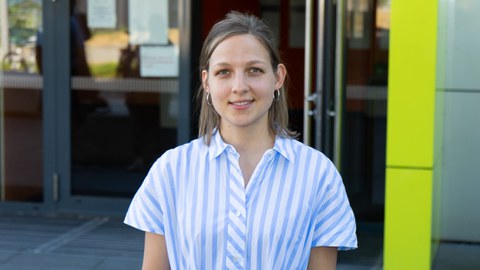Jul 13, 2022
Excellent diploma thesis: Schöck Construction Innovation Prize 2022 for Camilla Lewerenz
TUD graduate Camilla Lewerenz has been awarded the Schöck Construction Innovation Prize for her thesis "Investigation of the discontinuity areas of an orthocomposite roadway slab".
Since 2000, the Eberhard Schöck Foundation has honored up to four outstanding diploma or master theses in civil engineering with the prize. The aim is to promote innovative thinking and to realize buildings that are forward-looking, economical and/or durable. The prize is endowed with 2,500 euros.
In her work, for which Camilla Lewerenz also received the Züblin Steel Construction Prize in July, she examined the discontinuity areas that result from local wheel loads in the longitudinal and transverse direction of the bridge deck. For this purpose, she developed FEM models for a deck and a trough bridge in order to examine the stress on the dowel strips in particular. She designed framework models for the engineering calculation of the load transfer and submitted design proposals for the arrangement of the dowel strips and the formation of the reinforced concrete cover layer.
Abstract of the diploma thesis
The sharply increased traffic load and notch sharpness in the details of orthotropic steel plates lead to considerable fatigue damage to existing steel bridges. With the development of the ortho composite road slab (OVP for short), an alternative durable and lightweight composite construction method was created. A thin layer of topping concrete on a longitudinally stiffened sheet steel reduces the susceptibility to fatigue of the structure. The resulting shear forces between the cover sheet and the concrete layer are transferred by dowel strips. However, local stress concentrations due to wheel loads cause discontinuities within the OVP, in which there are increased stresses on the structure. These are in the connection area of the longitudinal and cross members and the center of the bay.
As part of the diploma thesis, these areas of the ortho-composite roadway slab were examined with composite dowel strips. The main focus was on the load transfer and the composite protection within the discontinuous areas of the roadway slab. The analysis and evaluation are based on finite element models, with which the geometry of the building and the traffic load was simulated. The framework models developed on the basis of the results create the basis for a simplified design of the discontinuity areas. Possible measures to reduce the shear stresses were also presented and investigated for areas in which increased composite shear forces occur. The results of the work form an important basis for the construction and dimensioning of the OVP.
Contact:
Prof. Richard Stroetmann,
Chair of Steel Construction

